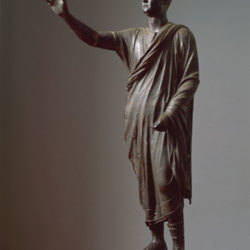L'Arringatore
Title
Date
Artist or Workshop
Materials
Height of the work
Provenience
Current Location
Description and Significance
Description:
The portrait of “L’Arringatore,” alternatively titled “The Orator” and “Aule Metele,” depicts a standing male figure in the adlocutio pose of oratorical address with a gently tilted head and extended arm. The composition is frontal with the body of the figure shown in contrapposto posture. The right arm is slightly bent and extends in front of the body. The left arm rests against the body, with the hand slightly clasped at the side of the toga. The third finger on the left hand wears a rounded ring. The figure wears the toga praetexta, a draped toga with a thick border over a loose striped tunic. It is believed that the stripes on the tunic were originally inlaid in a darker color of bronze. He wears calcei, formal laced shoes that cover the entirety of the foot, often worn by Roman senators with the toga in public settings. The face of the figure is modelled into an expression of somberness with a measure of Roman Republican verism in its truthful and non-idealized representation of the figure’s facial features. He has a furrowed brow line, lined and wrinkled neck, and close-cropped hair that begins to recede near the temples. The face sags slightly with age around the cheeks and chin, and the outer corners of the eyes show heavy crow’s-feet. The figure has a slightly bent aquiline nose and accentuated nasolabial folds in the fleshiest area of the face. On the hem of the toga, a retrograde inscription in Etruscan letters identifies the figure’s title, familial ties, and the sculpture’s role as a votive offering to “Sans” or Semo Sancus, the Roman god of trust and oaths.
Significance:
There is little known of the life of Aule Metele, the figure represented in the portrait of “L’Arringatore,” though the bronze portrait itself remains significant in showing the Romanization of art in the Italian peninsula during the Republican period. Roman rule expanded rapidly during the first century BC, and many groups of people, including the Etruscans, were directly impacted by Roman influence in all aspects of life. At the time of creation of “L’Arringatore,” all inhabitants of Italic nations became official Roman citizens under the dominion of the Republic. While it is believed that Aule Metele was an Etruscan citizen, as evidenced by the lettering on the hem of his toga and the possibility that the bronze was cast by an Etruscan artist, the clothing of the figure and his facial structure explicitly suggests the influence of his Roman citizenship as well. The figure’s costume depicts his status as a Roman citizen of equestrian rank, a political and administrative class and the lower of the two aristocratic classes of Rome. The sculpture is originally believed to have been placed within a temple as a public exhibition by public decree, erected as a votive offering by either Aule Metele or his family, though for reasons unknown. Metele wears the toga praetexta, the calcei, and the striped tunic associated with honorary and symbolic Roman dress for knights and magistrates—clothing that originated in Etruscan civilization and was absorbed into Roman culture. Scholars have expressed doubts in working to properly date the sculpture of “L’Arringatore” because of the length of the toga within honorary dress contexts of Roman and Etruscan civilization during the first century BC. The toga of “L’Arringatore” has been noted as being either too long or too short in context of its original placement. In viewing the portrait from a Roman context, by a Roman artist for exhibition in Rome, it has been suggested that the portrait belonged to the period of 150 BC before Romans substantially lengthened their togas in the later first century. However, if viewed from an Etruscan context, designed by an Etruscan artist for exhibition in Rome to show the merging of the two cultures, the shorter length of the toga indicates that the portrait dates from between 100-75 BC. Scholars commonly associate the sculpture with the latter date, though its definitive date is still uncertain. His right arm extended in oratorical address represents what scholars have termed “the appendage aesthetic” in Roman portraiture, in which a part of the body is emphasized by the artist for its ability to accentuate the meaning of the sculpture. Metele’s facial features are created in the veristic style of Roman portraiture: the face, features, and style follow the Republican model of portraits that suggest the “truthfulness” of the subject’s representation. Similar to the merging of Roman and Hellenistic customs seen in other portraiture from the period, Metele’s representation in “L’Arringatore,” shows the impact of the convergence of culture, customs, and influences between the Romans and other Italic civilizations, like the Etruscans, in Republican art.
References
"Adlocutio." Panel Reliefs of Marcus Aurelius and Roman Imperial Iconography, SUNY Oneonta, employees.oneonta.edu/farberas/arth/arth200/politics/aurelian_panels.html.
"Ancient Roman History: Eques." Encyclopedia Britannica, 20 July 1998, www.britannica.com/topic/eques.
Bonfante, Larissa. "The Language of Dress: Etruscan Influences." Archaeology, vol. 31, no. 1, Jan.-Feb. 1978, pp. 23-24, www.jstor.org/stable/41726854.
Carlson, I. Marc. "Roman Shoes: Calceus." Footwear of the Middle Ages, U of Tulsa, 2002, www.personal.utulsa.edu/~marc-carlson/shoe/SHOES/ROME/romshoe1.htm.
Dohrn, Tobias. Der Arringatore: Bronzestatue im Museo Archaeologico von Florenz. Berlin, Gebr. Mann Verlag, 1968. Monumenta artis Romanae 8.
Kleiner, Diana E. E. Roman Sculpture. Yale UP, 1994, pp. 33-34. Print.
Siebler, Michael, and Norbert Wolf. Roman Art. Koln, Taschen GmbH, 2007, pp. 30. Print.
"The Myth of Hercules at Rome." Roman History and Mythology, edited by Henry A. Sanders, New York, MacMillan Company, 1910, p. 177. Print.
Smith, Philip. "Toga." A Dictionary of Greek and Roman Antiquities, edited by William Smith, London, John Murray, 1875, pp. 1134-37. Print.
Contributor
Citation
Item Relations
This item has no relations.

